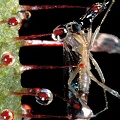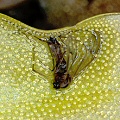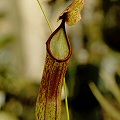Q: What do carnivorous plants eat?

Dinner!

Gross!

Hybrid Nepenthes
A: It depends on where they live.
Many carnivorous plants, such as Utricularia and Aldrovanda, live with their traps
submerged in water. These plants capture very small prey like rotifers and daphnia,
and even larger aquatic prey such as mosquito larvae and even fish fry.
Traps in the genus Genlisea can even capture protozoans, and some scientists think they are specialized
specifically to do so!
Meanwhile, Pinguicula and Drosera tend to catch flying insects
like gnats, flies, and moths. Pitcher plants (Sarracenia, Nepenthes, Cephalotus, etc.)
capture foraging insects, especially
flies, moths, wasps, butterflies, beetles,
and ants. Venus flytraps capture any crawling insect---mine feast particularly on spiders,
but plants in the wild have different diets.
Occasionally, oh yes, occasionally
vertebrates such as rats and birds have been captured. The carnivorous plants in these
cases have usually been Nepenthes (the tropical pitcher plant), but these are
rare
surprises and do not represent normal prey (any rat or bird that could not struggle, gnaw, or peck its
way out of a Nepenthes pitcher is probably sick or near
death from other causes). Frogs are more commonly
captured, but even this is fairly rare. Nepenthes more typically satisfies
its gluttonous appetite with crawling bugs and insects. Pass the centipedes,
please, I'd like another helping!
Venus flytraps have been observed with frog skeletons in their traps, so they also participate in the vertebrate
buffet! By the way, if you are interested to read about my experiments on whether
Venus flytraps can digest human beings,
look here. But be warned---it is a
definite gross-out page!
Page citations: Barthlott, W. et al. 1998; Brodie, J. and Lee, C. 2000;
Clarke, C. 1997, 2001; Juniper, B.E. et al. 1989;
Lloyd, F.E. 1942; Rice, B.A. 2006a; Schnell, D.E. 1976; Taylor, P. 1989.